Dirham
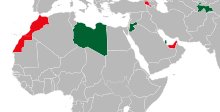

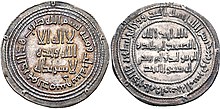
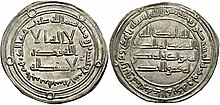




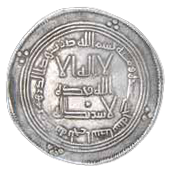
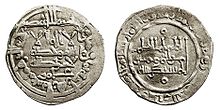

Thedirham,dirhemordrahm(Arabic:درهم) is a unit of currency and of mass. It is the name of the currencies ofMorocco,theUnited Arab EmiratesandArmenia,and is the name of a currency subdivision inJordan,QatarandTajikistan.It was historically a silver coin.
Unit of mass
[edit]The dirham was a unit of weight used across North Africa, the Middle East, Persia andIfat;later known asAdal,with varying values.
The value of Islamic dirham was 14 qirat. 10 dirham equals 7mithqal(2.975 gm of silver).
In the late Ottoman Empire (Ottoman Turkish:درهم), the standard dirham was 3.207g;[1]400 dirhem equal oneoka.The Ottoman dirham was based on theSasaniandrachm (inMiddle Persian:drahm), which was itself based on the Greek dram/drachma.[2]
InEgyptin 1895, it was equivalent to 47.661troy grains(3.088g).[3]
There is currently a movement within the Islamic world to revive the dirham as a unit of mass for measuring silver, although the exact value is disputed (either 3 or 2.975 grams).[4]
History
[edit]
The word "dirham" ultimately comes fromdrachma(δραχμή), the Greek coin.[5]The Greek-speakingByzantine Empirecontrolled theLevantand traded withArabia,circulating the coin there in pre-Islamic times and afterward. It was this currency which was initially adopted as a Persian word (Middle Persiandrahmordram); then near the end of the 7th century the coin became an Islamic currency bearing the name of the sovereign and a religious verse. The Arabs introduced their own coins. The Islamic dirham was 8daniq.[6]The dirham was struck in manyMediterranean countries,includingAl-Andalus(MoorishSpain) and theByzantine Empire(miliaresion), and could be used as currency inEuropebetween the 10th and 12th centuries, notably in areas withVikingconnections, such asViking York[7]and Dublin.
Dirham in Jewish orthodox law
[edit]Thedirhamis frequently mentioned inJewishorthodox lawas a unit of weight used to measure various requirements in religious functions, such as the weight in silver specie pledged in Marriage Contracts (Ketubbah), the quantity of flour requiring the separation of thedough-portion,etc. Jewish physician and philosopher,Maimonides,uses the Egyptiandirhamto approximate the quantity of flour fordough-portion,writing inMishnahEduyot1:2: "And I found the rate of the dough-portion in that measurement to be approximately five-hundred and twentydirhamsof wheat flour, while all these dirhams are the Egyptian [dirham]. "This view is repeated byMaran'sShulhan Arukh(Hil. Hallah,Yoreh Deah§ 324:3) in the name of theTur.In Maimonides' commentary of the Mishnah (Eduyot1:2, note 18), RabbiYosef Qafihexplains that the weight of each Egyptiandirhamwas approximately 3.333 grams,[8]or what was the equivalent to 16carob-grains[9]which, when taken together, the minimum weight of flour requiring the separation of the dough-portion comes to approx. 1 kilo and 733 grams. RabbiOvadiah Yosef,in hisSefer Halikhot ʿOlam(vol. 1, pp. 288–291),[10]makes use of a different standard for the Egyptiandirham,saying that it weighed approx. 3.0 grams, meaning the minimum requirement for separating thepriest's portion is 1 kilo and 560 grams. Others (e.g. RabbiAvraham Chaim Naeh) say the Egyptiandirhamweighed approx. 3.205 grams,[11]which total weight for the requirement of separating the dough-portion comes to 1 kilo and 666 grams. Rabbi Shelomo Qorah (Chief Rabbi ofBnei Barak) wrote that the traditional weight used inYemenfor eachdirhamweighed 3.20 grams for a total of 31.5dirhamsgiven as the redemption of one's firstborn son (pidyon haben), or 3.36 grams for the 30dirhamsrequired by theShulhan Arukh(Yoreh De'ah305:1),[12]and which in relation to the separation of the dough-portion made for a total weight of 1 kilo and 770.72 grams.
The worddrachmon(Hebrew:דרכמון), used in some translations of Maimonides' commentary of theMishnah,has in all places the same connotation asdirham.[13]
Modern-day currency
[edit]Currently the valid national currencies with the namedirhamare:
| Countries | Currency | ISO 4217code |
|---|---|---|
| Moroccan dirham | MAD | |
| United Arab Emirates dirham | AED | |
| Armenian dram | AMD |
Modern currencies with the subdivisiondirhamordiramare:
| Countries | Currency | ISO 4217code | Subdivision |
|---|---|---|---|
| Libyan dinar | LYD | Dirham | |
| Qatari riyal | QAR | Dirham | |
| Jordanian dinar | JOD | Dirham | |
| Tajikistani somoni | TJS | Diram |
The unofficialmodern gold dinar,issued and/or proposed by several states andproto-states,is also divided into dirhams.
See also
[edit]References
[edit]- ^based on an oka of 1.2828kg;Diran Kélékian gives 3.21 g (Dictionnaire Turc-Français,Constantinople: Imprimerie Mihran, 1911); Γ. Μπαμπινιώτης gives 3.203 g (Λεξικό της Νέας Ελληνικής Γλώσσας,Athens, 1998)
- ^"DIRHAM - Encyclopaedia Iranica".
- ^OED
- ^Ashtor, E. (October 1982)."Levantine weights and standard parcels: a contribution to the metrology of the later Middle Ages".Bulletin of the School of Oriental and African Studies.45(3): 471–488.doi:10.1017/S0041977X00041525.ISSN0041-977X.S2CID140561646.Archivedfrom the original on 2024-01-02.Retrieved2019-11-20.
- ^Oxford English Dictionary,1st edition,s.v. 'dirhem'Archived2020-02-09 at theWayback Machine
- ^BBC Art of Persia
- ^In addition to Islamicdirhamsin ninth and tenth century English hoards, a counterfeitdirhamwas found atCoppergate,inYork,struck as if forIsma'il ibn Achmad(ruling at Samarkand, 903-07/8), ofcopper covered by a once-silvery wash of tin(illustrated in Richard Hall,Viking Age Archaeology,[series Shire Archaeology] 2010:17, fig. 7).
- ^Mishnah – with a Commentary of Rabbi Moses ben Maimon,ed. Yosef Qafih, vol. 2 –Seder Neziqim,pub.Mossad Harav Kook:Jerusalem 1965, p. 189 (Hebrew title:משנה עם פירוש הרמב "ם)
- ^Mishnah – with a Commentary of Rabbi Moses ben Maimon(ed.Yosef Qafih), vol. 3,Mossad Harav Kook:Jerusalem 1967, s.v. Introduction to TractateMenahoth,p. 68 (note 35) (Hebrew)
- ^Ovadiah Yosef,Sefer Halikhot ʿOlam,vol. 1, Jerusalem 2002 (Hebrew title:ספר הליכות עולם)
- ^Ovadiah Yosef,Sefer Halikhot ʿOlam,vol. 1, Jerusalem 2002, p. 288, sec. 11; Abraham Chaim Naeh,Sefer Kuntres ha-Shi'urimArchived2017-04-24 at theWayback Machine,Jerusalem 1943, p. 4 (Hebrew)
- ^Shelomo Qorah,ʿArikhat Shūlḥan - Yilqūṭ Ḥayyīm,vol. 13 (Principles of Instruction and Tradition), Benei Barak 2012, p. 206 (Hebrew title:עריכת שולחן - ילקוט חיים)OCLC762505465
- ^Mishnah – with a Commentary of Rabbi Moses ben Maimon,ed. Yosef Qafih, vol. 3 –Seder Kodashim,pub.Mossad Harav Kook:Jerusalem 1967, s.v. Introduction to TractateMenahoth,p. 68 (note 35) (Hebrew title:משנה עם פירוש הרמב "ם)
